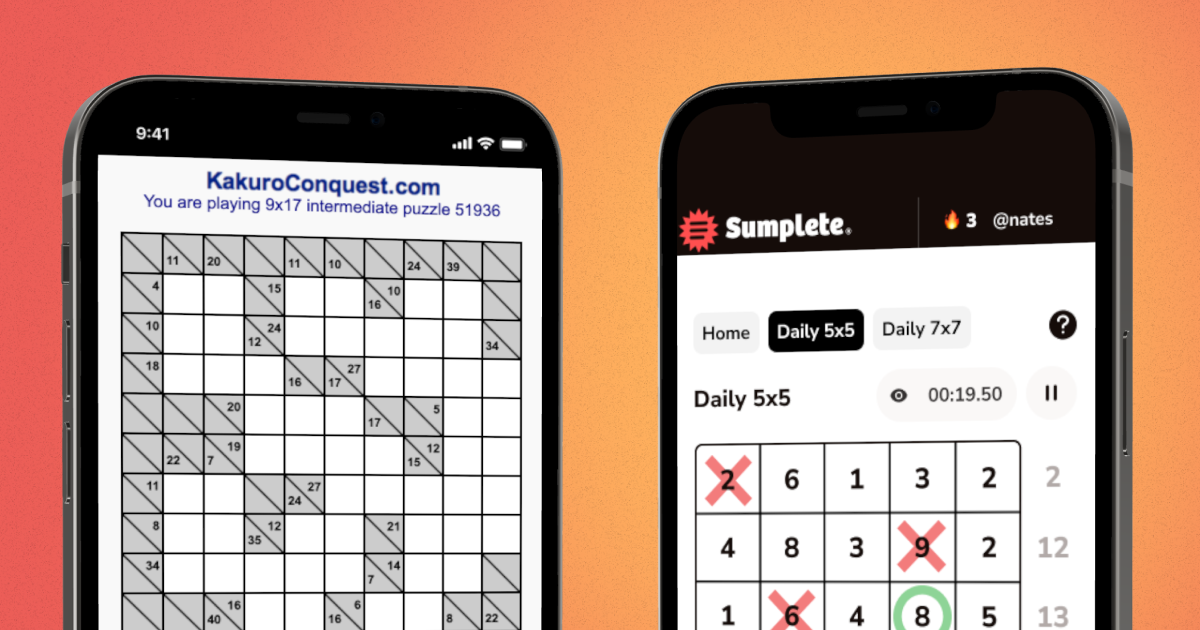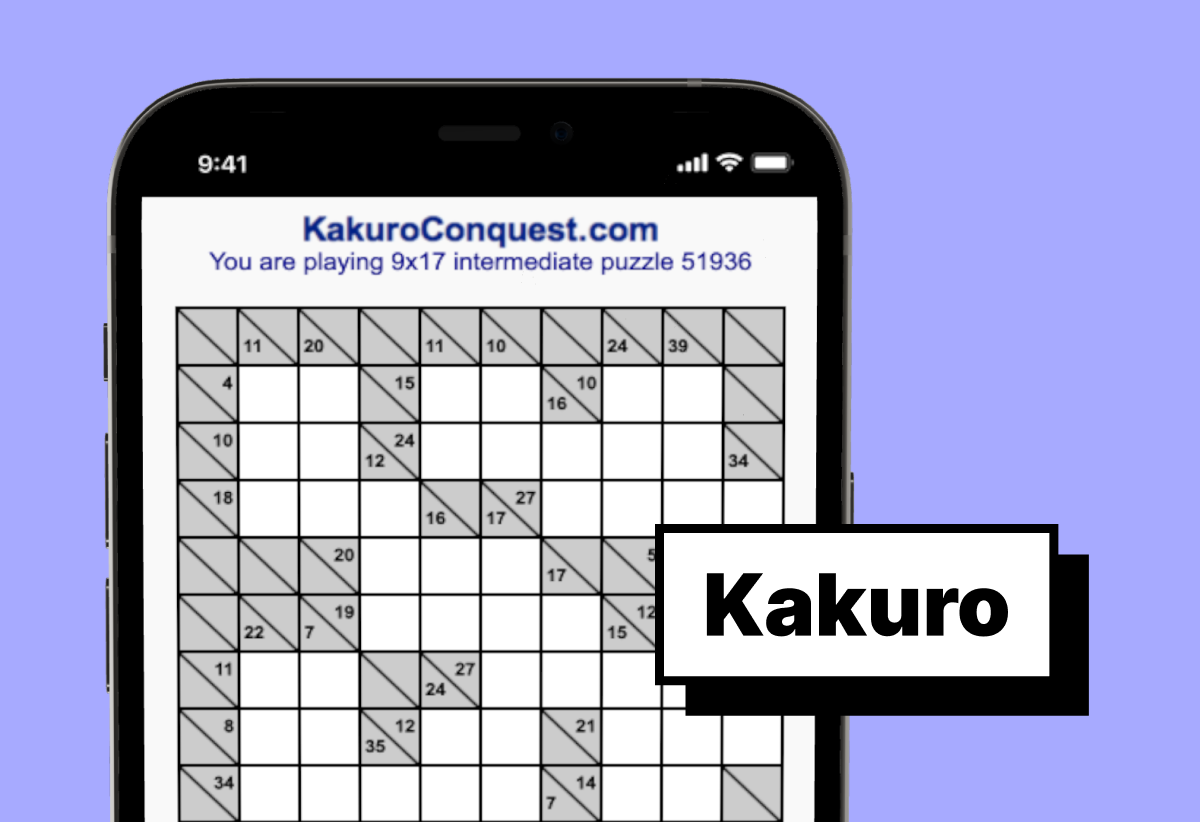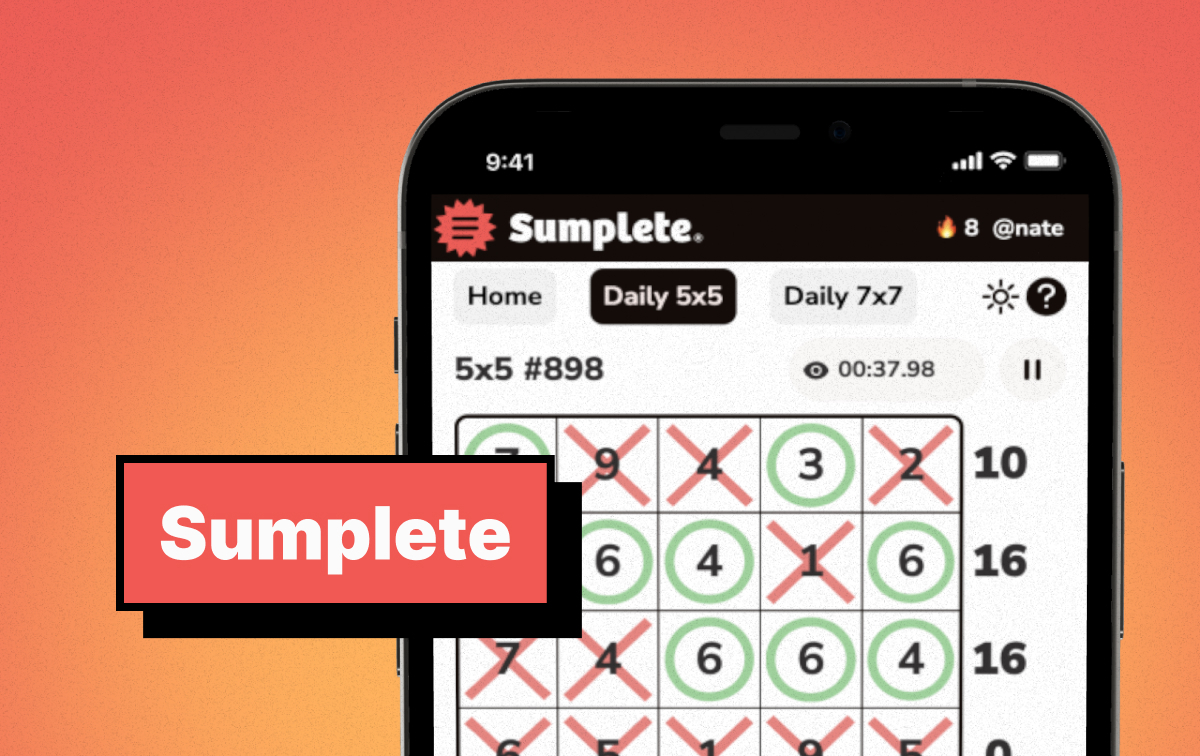Kakuro vs Sumplete: Rules, Difficulty & Which Puzzle Fits You
Related: Number Logic Puzzles: Daily Guide (Sumplete + 7 Alternatives)

What are the differences between Sumplete and Kakuro?
Sumplete and Kakuro are two number-based games with different objectives.
Sumplete requires players to eliminate and select cells on the playing board so that the sum of the remaining values in each vertical and horizontal line matches their corresponding sum clues. Kakuro challenges players to fill empty spaces on a grid so that each horizontal row of numbers adds up to the closest pre-filled cell to the left and each vertical column matches the value in the closest pre-filled cell above (without repeats).
Practice grids: 3×3, 4×4, 5×5, 6×6, 7×7, 8×8, 9×9.
Daily levels: 5×5 and 7×7 (Master).
Kakuro boards come in various sizes and levels of difficulty. Beginners typically start with the easier 4x4 and 6x6 grids before progressing to the 8x8 grid, which is closer to a medium level of difficulty. Those seeking a true test can attempt the more difficult 9x11 and 9x17 boards.
Side-by-Side Rules Comparison
| Step | Kakuro | Sumplete |
|---|---|---|
| 1 | Read across/down clues; note each run’s length and target. | Read fixed row/column targets; they don’t change. |
| 2 | Build candidate sets that sum to the clue with no repeats. | Cross out any cell that would push a line past its target. |
| 3 | Use intersections to fix digits and complete runs. | Use intersections to zero lines; re-scan residuals as sums drop. |
Keep long technique links outside the table for cleaner parsing.
Game Elements Comparison Table
| Game Elements | Kakuro | Sumplete |
|---|---|---|
| Core mechanics | Cross-sum entries | Elimination-style sums |
| Math needed | Combinations & partitions | Quick arithmetic |
| Grid sizes | 4×4, 6×6, 8×8, 9×11, 9×17 | Practice 3×3-9×9; Daily 5×5 & 7×7 |
| Average solve time | 10–20 min | 3–8 min |
| Learning curve | Steeper for beginners | Easy to learn (3 steps) |
| Mobile UX | Mobile-friendly versions available | Larger tap targets; auto-mark helper |
| Difficulty band | Easy → Expert | Easy → Master |
| Best for | Math-logic purists | Quick daily brain boost |
What are the Differences in Strategy for these Games?
Kakuro and Sumplete have similar elements, but the common strategies for each game differ greatly.
Kakuro Techniques

- It’s important to create lists of “candidate sets,” or numbers that could work as values in a given sum. This will help you keep track of which combinations can be eliminated from consideration.
- Pruning intersections for possible repeats or invalid inputs can also help determine values as you progress. If a set of numbers works vertically, but is invalid horizontally, you know that one or more of your values is invalid.
- Forced runs, or lines that can only be solved with a single combination of values, can be tremendously helpful if identified early. Detecting forced runs at the beginning of a game can help drastically reduce your time to solve.
Sumplete Techniques

- Prioritize knocking out smaller sum clues first. Smaller sum clues will have fewer eligible candidates per line, and some candidates may even exceed the sum clue itself!
- Take note of complementary pairs or triples — finding the right combination of one of these sets will enable you to eliminate a substantial amount of cells very quickly.
- Don’t forget to track your residuals! Take inventory of the remaining numbers on your grid after solving a few lines and check to see if any of those cells can possibly fit into any of your board’s unsolved sum totals.
- Once you’ve confidently selected and circled cells in a given line, click the sum clue itself to auto-mark the rest of the values in that grouping. This can help save you precious seconds off your time to solve!
What are some Common Mistakes for Each Game?
Common Kakuro mistakes include repeating digits in a specific grouping, failing to cross-check intersecting lines, and ignoring the length of the grouping, which, in turn, result in incorrect calculations by the player.
Sumplete players may make mistakes by focusing on big sum clue targets too early, over-clearing lines to the point where there are no eligible candidates left to solve for the sum clue, and neglecting intersecting lines, which can cause rows to match their sum clue but render columns invalid (and vice versa).
Which Game Should You Play?
Different players will seek different puzzles depending on what they are looking to get from their experience!
If you’re seeking a fast daily mental workout between 3–8 minutes, you should try Sumplete 5×5/6×6.
Perhaps you desire a deeper, puzzle-by-puzzle challenge that can take anywhere from 10 to 20 minutes (or longer) to solve. In that case, try a moderately challenging Kakuro board.
Maybe you just want a game that can help you sneak in some extra math practice. If that sounds like you, either game could be a good fit! Kakuro leans into combinations and partitions, whereas Sumplete focuses on mental addition speed.
FAQ
Is Kakuro harder than Sumplete?
Both games have varying grid sizes and difficulty levels, so it’s difficult to say that one is harder than the other. Different players might have different experiences with each game as well.
What’s a good solve time for each?
Average solve times for both games fluctuate depending on the selected grid size and level of difficulty.
New Sumplete players usually complete the 5x5 daily board within 2 to 4 minutes. A solid time for the 6×6 board is anywhere between 4 and 6 minutes, and a time between 6 and 10 minutes for the 7×7 Master is quite impressive as well.
Kakuro boards typically take a bit longer to solve, with most players solving the easy and standard puzzles within 10 to 20 minutes. Some of the more advanced boards, however, can take as long as an hour or longer to solve.
Do I need advanced math for either game?
No, advanced mathematical equations are not required for either game. Both games use basic mathematical equations. However, the length and complexity of those equations are dependent upon the grid size and difficulty level selected.
Can kids learn these puzzles?
Yes, kids can learn these puzzles by starting with the easier levels of each game! Sumplete is better for younger children who are still working on their basic addition and subtraction skills, whereas Kakuro is better suited for older students seeking a slightly more advanced math-based game.
Where do I play daily versions?
Access Sumplete’s Daily 5x5 and 7x7 boards by clicking the links below:
To play a daily Kakuro, we recommend visiting Kakuro Conquest’s website to get started!
Final Verdict & Next Steps
The final verdict:
If you find fast, math-logic puzzles to be satisfying challenges, we recommend you start with Sumplete. Try the Daily 5×5 or Unlimited 6×6 to get started before progressing to some of the more difficult boards!
If you prefer to construct exact digit combinations and solve for longer equations, pick Kakuro to scratch that methodical itch! The 4x4, 6x6, and 8x8 boards are your best bets if you are new to the game. If you’re a Kakuro pro, try the 9x11 or 9x17 boards to put your skills to the test!